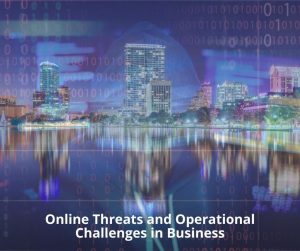 In today's digital age, businesses are increasingly reliant on technology to drive operations, enhance productivity, and deliver services. However, this digital transformation comes with its own set of challenges, particularly in the form of online threats and operational challenges that can disrupt business operations. Grasping the nature of these threats and their potential impact is essential for safeguarding your business.
In today's digital age, businesses are increasingly reliant on technology to drive operations, enhance productivity, and deliver services. However, this digital transformation comes with its own set of challenges, particularly in the form of online threats and operational challenges that can disrupt business operations. Grasping the nature of these threats and their potential impact is essential for safeguarding your business.
Here, we delve into the various types of online threats and operational challenges that can hinder business operations.
- Social Engineering
What It Is: Social engineering entails persuading individuals to reveal sensitive information or take actions that undermine security.
Types of Social Engineering Attacks:
-
-
- Phishing: Tricking individuals into providing sensitive information via fake websites, emails, or messages.
- Spoofing: Creating fake websites or sending emails that appear legitimate.
- Smishing: Sending fraudulent SMS messages to trick recipients into clicking malicious links.
- Vishing: Using phone calls to impersonate legitimate organizations and gather information.
- Whaling: Targeting high-profile individuals such as executives.
- Pretexting: Creating a fabricated scenario to steal information.
- Baiting: Luring victims with promises of goods or services to extract information.
- Tailgating: Following authorized personnel into restricted areas.
- Quid Pro Quo: Offering a benefit in exchange for information.
-
Impact on Businesses: Social engineering can lead to data breaches, unauthorized access to sensitive areas, and significant financial losses. It exploits human psychology rather than technical vulnerabilities, making it particularly insidious.
- Ransomware
What It Is: Ransomware locks up your files with encryption, holding them hostage until you pay a ransom to regain access.
Impact on Businesses: Ransomware can bring business operations to a halt. The cost of the ransom, coupled with downtime and data recovery efforts, can be substantial. This could mean significant delays in order fulfillment and delivery schedules, leading to customer dissatisfaction and potential financial losses.
- Distributed Denial of Service (DDoS) Attacks
What It Is: DDoS attacks flood websites or networks with traffic from multiple sources, causing them to become inaccessible to users.
Impact on Businesses: DDoS attacks can cause significant downtime, affecting customer access to your services and resulting in lost revenue. Prolonged downtime can also harm your business reputation and customer trust. A DDoS attack could disrupt online ordering systems and warehouse management systems, causing operational chaos.
- Insider Threats
What It Is: Insider threats involve employees or other insiders who intentionally or unintentionally cause harm to the organization’s digital infrastructure.
Impact on Businesses: Insider threats can result in data breaches, intellectual property theft, and financial losses. These threats are particularly challenging because insiders already have authorized access to systems and data. This could mean compromised inventory data or leaked sensitive information about logistics operations.
- Malware
What It Is: Malware is purpose-built software designed to disrupt computers, servers, clients, or networks with malicious intent. Common types include viruses, worms, Trojan horses, and spyware.
Impact on Businesses: Malware can steal sensitive information, disrupt operations, and cause financial losses. It can also be used to create backdoors for further attacks. Malware can compromise logistics software, inventory management systems, and customer databases.
- Supply Chain Attacks
What It Is: Supply chain attacks exploit vulnerabilities in weaker links of the supply chain to infiltrate larger organizational networks.
Impact on Businesses: These attacks can compromise business operations by disrupting the supply chain. Businesses may also suffer from data breaches and financial losses. A supply chain attack could lead to delays, increased costs, and loss of customer trust.
- Network Issues
What They Are: Network issues encompass a range of problems that can affect the performance, reliability, and security of a business's IT infrastructure. These can include bandwidth bottlenecks, hardware failures, configuration errors, and security vulnerabilities.
Impact on Businesses: Network issues can lead to downtime, slow performance, and data loss. For example, if a business network is not properly configured or maintained, it can become a target for cyber-attacks such as DDoS. Network issues can also disrupt communication between systems, affecting everything from email services to inventory management and order processing.
- Hardware Failures
What They Are: Failures of physical components like servers, hard drives, or network devices.
Impact on Businesses: Hardware failures can result in data loss, downtime, and the need for costly repairs or replacements. This can interrupt business operations and delay service delivery.
- Software Bugs and Compatibility Issues
What They Are: Errors or incompatibilities in software that can cause applications to malfunction.
Impact on Businesses: Software issues can disrupt workflows, lead to data corruption, and reduce productivity. Maintaining up-to-date and compatible software across all systems is crucial to minimizing these challenges.
- Human Error
What It Is: Mistakes made by employees, such as misconfiguring systems or accidentally deleting important files.
Impact on Businesses: Human errors can lead to data loss, security breaches, and operational inefficiencies. Implementing comprehensive training and having robust backup solutions can mitigate these risks.
Proactive Measures to Mitigate Online Threats and Operational Challenges
Understanding the nature of online threats and operational challenges is the first step toward mitigating them. Here are some proactive measures businesses can take to protect their operations:
- Implement Comprehensive Cybersecurity Training: Educate employees about phishing, social engineering, malware, and other common cyber threats. Ensure they know how to recognize and respond to suspicious activities.
- Deploy Advanced Security Solutions: Invest in robust antivirus software, firewalls, and intrusion detection systems. Regularly update and patch all software to protect against vulnerabilities.
- Develop an Incident Response Strate: Develop a comprehensive plan to swiftly address Cybersecurity incidents, covering containment, eradication, recovery, and communication protocols.
- Conduct Regular Security Audits: Keep your network strong with routine security audits and penetration testing to uncover and fix vulnerabilities.
- Secure Your Supply Chain: Screen suppliers and partners rigorously to guarantee adherence to robust Cybersecurity standards. Implement stringent security measures to safeguard against supply chain attacks.
- Backup Critical Data: Regularly back up your data and ensure backups are stored securely and are accessible in case of a ransomware attack or data loss.
- Optimize and Monitor Your Network: Ensure your network is properly configured, regularly maintained, and continuously monitored for performance issues and potential security threats.
Looking Ahead: Strengthening Your Cybersecurity Posture
In today's digital age, businesses face abundant opportunities alongside substantial risks. By understanding the different types of online threats and operational challenges and taking proactive measures, businesses can protect their operations, safeguard their data, and maintain the trust of their customers.
Stay engaged and informed as we explore specific threats and issues that businesses face today. Gain an in-depth understanding of these common threats and their impact on business security and operations.









